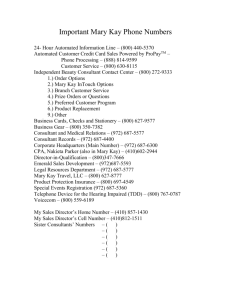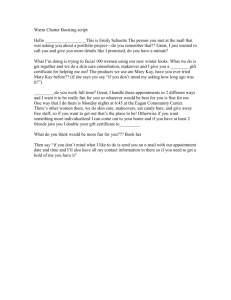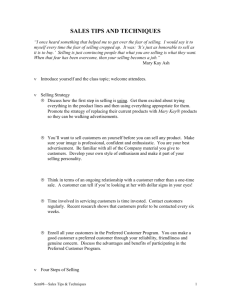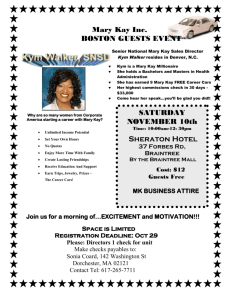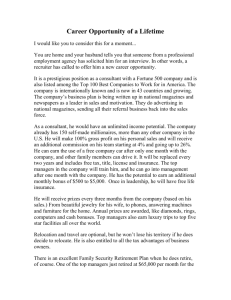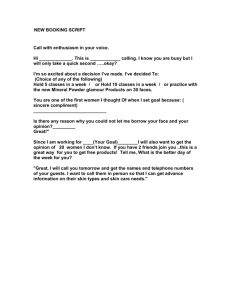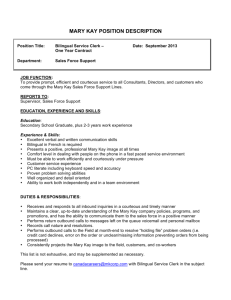Secondary Research Project
advertisement
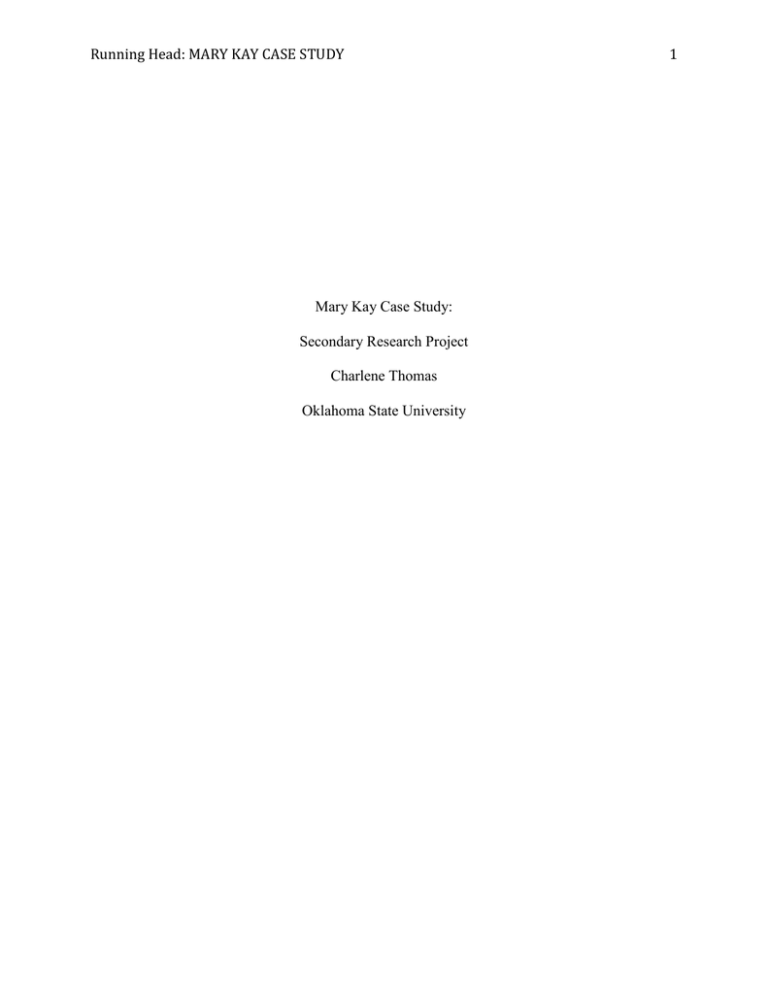
Running Head: MARY KAY CASE STUDY Mary Kay Case Study: Secondary Research Project Charlene Thomas Oklahoma State University 1 2 Running Head: MARY KAY CASE STUDY Abstract This paper touches on the 2013-2014 Case Study that Mary Kay has issued. Mary Kay’s main goal is to expand its demographic a younger set of women between the ages of 18-25. Research was conducted on target demographics, history of the company, competitors, and the industry. Mary Kay has been thriving since the early 1960’s and is continuing to do with the Case Study they put out this year. In this paper is a situational analysis along with strengths and weaknesses of the company. The main competitor is Avon as well as the mass retailers around the world. The Mary Kay industry has several consumers who are loyal to their brand and product. Now it is time for the company to find new and fresh ways to reach their goal of a target audience of 18-24 year old women. Running Head: MARY KAY CASE STUDY 3 Mary Kay Case Study Company/Brand A woman whom had a dream, and a savings account with roughly five thousand dollars founded Mary Kay Cosmetics in 1963. This woman goes by the name of Mary Kay Ash. With the help of her son, then 20 years old, she took her idea and ran with it. Speaking of Ash in the NSAC Case Study (2013), “Her work ethic, approach to business, and success resulted in numerous awards and recognitions including, but not limited to, the Horatio Alger American Citizen Award, ‘America’s 25 Most Influential Women”,’ and the National Business Hall of Fame”. When starting her business Ash came up with four core values for the company that still stand today: 1. The Golden Rule. Treat others as you would like to be treated. 2. Life’s Priorities Placed in Proper Order. Faith first, family second, and career third. 3. Make Me Feel Important. Imagine everyone is wearing a sign that reads, “Make me feel important.” Running Head: MARY KAY CASE STUDY 4 4. Go-Give Spirit. The willingness to help one another knowing that this spirit creates positive reciprocity. Mary Kay Ash came into the business as an incredible positive influence for women all over the world. According the Rosenfield (1981), “With her passion to help others help themselves, she has brightened the lives of thousands and become one of the most influential and respected personalities in philanthropic and business circles.” Not only has Ash created a successful and thriving company, but also she lives on to be a hero to those who know her work. Since the start of the company, Mary Kay has used direct selling as their approach. They also use something called a “party plan” whereas the IBC’s of the company host a party in a current customer’s home to try and broaden their sales. This approach is beneficial to potential customers because of the hands-on factor of getting to try some of the products before actually buying them. Becoming an IBC for Mary Kay can go further than just selling products. They can take on leadership roles, recruit other possible IBC’s, and more while earning more income. In the past, Mary Kay has naturally advertised to an older demographic. Ash being a middle-aged woman when starting the company and advertising things like wrinkle cream. However, speaking about an article concerning a new nail kit out from Mary Kay, according to White (1999), “To add some additional flair, try Mary Kay's matching lip colors such as Strike-A-Pose Rose or Shimmery Downtown Brown”. When referring to “striking a pose” or “shimmery downtown”, most would assume a younger generation is being targeted. In this article, White used a young, African-American for his advertisement photo. Industry Overview Makeup has been used in the world for centuries. Dating back to the time where women used to take rose leaves and rub them on their cheeks for a blush effect. According 5 Running Head: MARY KAY CASE STUDY to Forbes.com (2009), “Mary Kay is the number two direct seller of beauty products/cosmetics in the United States behind Avon”. In the same issue Mary Kay was named #175 out of America’s largest private companies. Starting out in the business Mary Kay only issued a mere ten products. That has grown significantly since, but making their demographic smaller than it needs to be. Mary Kay has always fancied the middle-aged women, rather than a younger target audience. Marketing Weekly News (2010), says, “Mary Kay ranked number one among all cosmetic brands in consumer loyalty according to the 2010 Brand Keys Customer Loyalty Engagement Index”. This industry has many women who go back and forth from product to product, experiencing with different brands even, but this one holds the cake for the most loyal customers. Customers who stay consistent with any company say a lot about the product. There is a current trend with young makeup users in the last couple years. 18-24 year olds are subscribing to a company where they get a box for a flat rate each month, which contains a handful of samples from their latest products. Younger adults don’t commit to something near as much as older adults. This lets them try something beforehand so they can buy it in the future, and who doesn’t like getting a surprise box in the mail every month? Nonetheless, young women are using less beauty products this year than ever before. According the Huffingtonpost.com (2013), ”In a study of women ages 18-25, 67 percent said they use 0-3 products in their morning hair and beauty routine. In contrast, 20 percent said they use 4-7 products and 10 percent said they use 8-12 products. Only 3 percent of young adult women use 12+ products in the morning”. Competitors Running Head: MARY KAY CASE STUDY 6 The cosmetic industry is ever evolving and becoming larger. With that being said, not only are direct selling companies competitors, but traditional retailers, online companies such as Birchbox, and so many more. Avon was founded all the way back in 1886, making them Mary Kay’s biggest competition since it began. Avon too, is a direct selling company that has a reputation for sliding in first for many years. However, according to Campaign Asia- Pacific (2011), “Despite being one of the first direct-selling companies to enter China back in 1990, alongside Amway and Mary Kay, last year China was the only market where Avon posted a loss”. Since Mary Kay is now trying to direct their sales to an 18-24 demographic, they should possibly consider setting up something in the traditional retail world. The weakness for Mary Kay is to get any products; one must find a direct seller to purchase anything. Most young women of that age tend to shop at drugstores, specialty stores, such as Sephora and Ulta. However, if Mary Kay could get a younger audience to love their brand, all they would need to do is become an IBC and they would be able to purchase product anytime. Online retail has started booming in the last decade. People would rather purchase something in the comfort of their own home than to go out and fight a crowd. According to NCAS Case Study (2013), “Brand/Product Strengths include: 1. Trusted and quality products 2. Botanical Effects, Clear Proof & at play product lines 3. Once they try the products they like them 4. Try before you buy 5. Corporate Social Responsibility platforms 6. Well established and high caliber reputation 7 Running Head: MARY KAY CASE STUDY A strategy Mary Kay may want to use is an online shopping site similar to Birchbox where consumers can buy what they want, when they want. Another possible sale could be the once-a-month box full of the newest samples rather than having to set up a party to do so. Target Audience According the Pinktruth.com (2013), “Number of females in the U.S. (roughly): 157 million”. The Pinktruth also commented on females who are below middle class in the U.S. Why would one pick out a $15 lipstick from Mary Kay, when they get roughly the same one at Target for $5? They’re reaching out to a demographic of 18-24 year olds who are typically in college or just starting out in the career world. Most women of that age refuse to pay a lot for simple makeup. The lifestyle of makeup for this demographic is more like self-expression for young women. The cosmetics they buy and where are a reflection of their attitude and personality. According to millennialmarketing.com (2012), “69% of women 18-24 say they ‘wear makeup to express my personality,’ compared to just 55% for all women”. It would be beneficial to Mary Kay if they worked on relating on a deeper level to the demographic since it has been proven that women wear makeup for expression, not just to cover up their face. Mary Kay sells their product all over the globe. From China, Brazil, Korea and many more. Their main sells are in the United States. The demographic behavior Mary Kay is reaching for, tends to look up to celebrities with what they’re using along with what America’s favorite TV show is advertising. According to Examiner.com (2013), “Now, they have chosen Mary Kay...yes, the same Mary Kay that has been around for 50 years...my Mary Kay to be their one and only makeup brand used on the show!” Media outlets as well 8 Running Head: MARY KAY CASE STUDY help target certain demographics. Popularity gets a large follow on social media when people see others “liking” certain pages excessively, it becomes like a domino effect, and others follow in the same direction and quickly. According to Magsaysay (2011), “Mary Kay cosmetics, one of the most recognizable brands in direct-sales cosmetics has a 1-year-old Facebook page that has attracted more than 300,000 fans who engage in online polls and makeover contests and watch YouTube videos about new products”. This number has grown just in the last two years to over 1 million. Therefore, social media plays a huge role on who is seeing what. REFERENCES Avon needs to regain its gloss in china. (2011, 10). Campaign Asia - Pacific. Retrieved from http://search.proquest.com/docview/963973490?accountid=3320 *Cosmetics; mary kay tops consumer loyalty list in new national survey. (2010). Marketing Weekly News, , 1251. Retrieved from http://search.proquest.com/docview/760884029?accountid=3320 For Millennial Women, Beauty is Fun | Millennial Marketing. (n.d.). Retrieved from http://millennialmarketing.com/2012/08/for-millennial-women-beauty-is-fun/ Running Head: MARY KAY CASE STUDY 9 Magsaysay, M. (2011, Jan 30). BEAUTY; direct-sales cosmetics 2.0; avon, mary kay, votre vu and more move beyond sales parties to market via social networking sites. Los Angeles Times. Retrieved from http://search.proquest.com/docview/848392689?accountid=3320 Mary Kay Featured On Project Runway This Fall - Tampa Bay Women's Health | Examiner.com. (2013, August 8). Retrieved from http://www.examiner.com/article/mary-kayfeatured-on-project-runway-this-fall *MARY KAY NSAC case study(2013-2014). Mary Kay. *Rosenfield, P. (1981). THE BEAUTIFUL MAKE-UP OF MARY KAY. Saturday Evening Post, 253(7), 58-107. *Study: Young Women Aren't Actually Using That Many Beauty Products. (2013, August 28). Retrieved from http://www.huffingtonpost.com/2013/08/28/young-women-beautyproducts_n_3828990.html *TRACY (2013, August 9). Pink Truth » Market Saturation and Mary Kay. Retrieved from http://www.pinktruth.com/2013/08/market-saturation-and-mary-kay/ White, R. (1999, May 27). Summer 1999 nail tips. New York Amsterdam News. p. 19. Running Head: MARY KAY CASE STUDY #175 Mary Kay - Forbes.com. (2009, October 28). Retrieved from http://www.forbes.com/lists/2009/21/private-companies-09_Mary-Kay_9ETL.html 10

